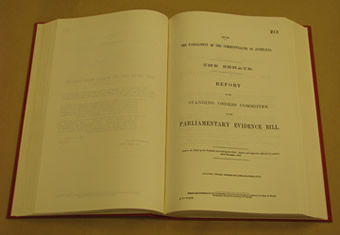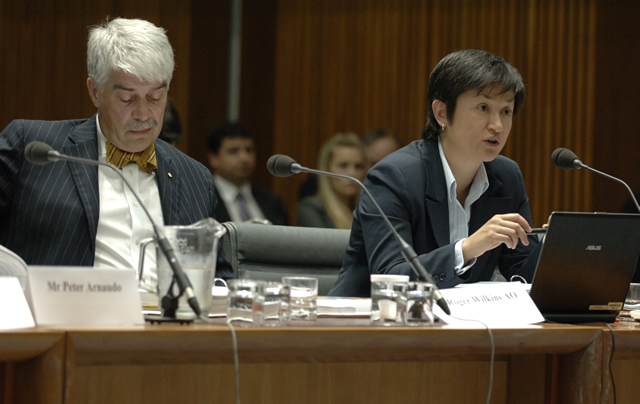176 Summoning of witnesses
-
Witnesses, other than senators, may be ordered to attend before the Senate by summons signed by the Clerk, or before a committee by summons signed by the secretary of the committee.
-
If a witness fails or refuses to attend or give evidence, the matter shall be reported to the Senate.
Amendment history
Adopted: 19 August 1903 as SOs 372 and 373 (corresponding to paragraphs (1) and (2)) but renumbered as SOs 368 and 369 for the first printed edition
Amended: 1 September 1937, J.44 (to take effect 1 October 1937) (updating of terminology to refer to the “Clerk of the Senate” rather than the “Clerk of the Parliaments”)
1989 revision: Old SOs 382 and 383 combined into one, structured as two paragraphs and renumbered as SO 176; language modernised and terminology updated to refer to committee secretaries, rather than clerks
Commentary
This standing order is the first of a series of eight standing orders governing the calling of witnesses before the Senate and its committees. The fact that they were adopted without debate and continued in force with only a minor, technical amendment until 1989 reflects their origin in the South Australian House of Assembly standing orders which embodied the standard parliamentary practice of the day. Undergoing only minor and technical revision in 1989, the standing orders relating to witnesses have been augmented by the adoption of a more comprehensive code for the treatment of witnesses before committees in the 1988 Privilege Resolutions, and by the recognition that any examination of witnesses at the bar of the Senate would also require more comprehensive procedures (see SO 182).

The Parliamentary Evidence Bill 1904 was a private senator's bill introduced by Senator Neild (FT, NSW). It did not proceed although the extent to which it was misconceived was not recognised at the time
One standing order in the group was deleted in its entirety in 1989 – old SO 386. That standing order set out the procedures to be followed by a committee when, during the course of an inquiry, it found information that made charges against any senator. Although it had been used as recently as 1975,[1] in 1989 it was noted that the meaning of the provisions was obscure, and that if the matter was relevant to the inquiry, the committee should be able to consider the charge and if it were not, the committee probably should not report it to the Senate.[2]
While the standing orders relating to witnesses were adopted without debate in 1903, the issue of summoning witnesses was explored by the early Senate in the debate on the Parliamentary Evidence Bill in 1904. The bill sought to clarify parliamentary powers to summon witnesses and to administer the oath or affirmation in light of different practices adopted by select committees.[3] During debate it was uncontested that the Senate had the power under s.49 of the Constitution to summon witnesses and administer oaths.[4] The issue lay with the machinery for administering oaths and affirmations and the consequence of failing to do so if the witness then gave false or misleading evidence. The proponent of the bill, Senator Neild (FT, NSW), expressed the view that under the standing orders those who gave false evidence under oath or affirmation could be punished. However, if evidence were taken “without such safeguard, there does not appear to be any means of bringing a dishonest or untruthful witness to punishment”.[5] The question of whether the matter would be best dealt with by standing order was flagged and, as a consequence, the bill was referred to the Standing Orders Committee after its second reading.[6]
The Standing Orders Committee reported, advising that the Senate should proceed with the bill:
… but that its scope should be enlarged by the addition of clauses dealing with the whole matter of the summoning and examination of witnesses.
To do this clauses will have to be inserted for the punishment of witnesses:
-
who do not attend when summoned;
-
who refuse to be sworn;
-
who refuse to answer questions.
Although the Committee consider that both the Senate and the House of Representatives and the Committees of either House have power under the Constitution to administer oaths, and that the Senate and the House of Representatives have power respectively to deal with any witness who refuses to attend, to be sworn, or to answer questions, they do not consider that the time of Parliament should be taken up by matters of this nature, but that the Courts are better constituted to adjudicate on such matters.[7]
The committee’s view did not prevail. The bill, a private senator’s bill, proceeded no further and original SO 369 continued in force. The question of committee powers arose again in 1913 when the Parliament contemplated establishing joint committees to examine public works proposals and government accounts. Because joint committees were not encompassed by s.49 of the Constitution, the new committees were established by statute and their powers in relation to witnesses codified to include power to take evidence on oath.[8] Despite Senator Neild’s uncertainty when putting forward his bill, whether a witness gives evidence on oath has no effect on the witness’s obligation to give truthful evidence or on the Senate’s ability to deal with an untruthful witness. These matters were put beyond doubt in 1988 by the Senate’s declaration in Privilege Resolution 6 of matters that may constitute contempts. Knowingly giving false or misleading evidence may be treated as a contempt, as may refusing to make an oath or affirmation without reasonable excuse.[9]
A minor technical amendment was made in 1937 to take account of the fact that the “Clerk of the Senate” was the correct title of the Clerk, not “Clerk of the Parliaments” as was the case in 1903. For background on the change in terminology, see SO 137 and Appendix 4.
The 1989 revision removed superfluous provision for examination of witnesses before a committee of the whole which had never been used. By that time, the strengthening and growth of the Senate’s committee system as well as the historical use of the standing order made it highly unlikely that a witness would ever need to be examined by a committee of the whole. On the few occasions when the standing order had been used, witnesses were called to the bar of the Senate with the President presiding (see SO 182).

Witnesses before the Legal and Constitutional Affairs Committee (Photo courtesy of AUSPIC)
Paragraph (2) which outlines a process for dealing with recusant witnesses originally provided not only for the matter to be reported to the Senate but for the Senate to deal with it. This mandatory direction to the Senate was deleted by the 1989 revision.
The 1988 Privilege Resolutions also added a further dimension to the standing order. Privilege Resolution 1 (1) makes it clear that the established practice in the Senate is to invite witnesses to give evidence and to summon a witness only when the circumstances warrant it.
It has become relatively common for these procedures to be by-passed by a resolution of the Senate ordering particular witnesses to appear before committees. See Odgers’ Australian Senate Practice, 13th edition, pp.530n, 542n for further details.